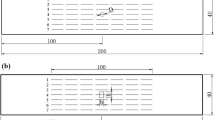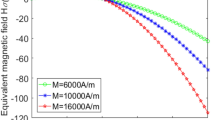Abstract
Metal magnetic memory testing (MMMT) is a nondestructive testing method for the early diagnosis and prevention of ferromagnetic metal components. Many scholars have studied the effect of uniform stress on the self-magnetic-leakage field (SMLF) strength of ferromagnetic materials. However, there are still insufficient studies on stress concentration caused by uneven force under the combined action of bending and shear. In this study, MMMT applied to bridge steel structures and its applicability in monitoring damage to steel structures under complex stresses was explored, and a static loading test was carried out on a steel box girder model. We studied the distribution law of the SMLF on the surface of the top flange, bottom flange, and web of the steel box girder and the force-magnetic relationship of magnetic signal measuring points that were symmetrical with the strain measuring points. Furthermore, we analyzed the magnetic parameters from the statistical point of view to characterize the critical yield state at different force parts of the steel box girder. The results indicated that the stress concentration position at different force parts of the steel box girder could be determined by the peak value of the distribution curve of the normal component \(H_{{\text{p}}} (y)\) of the SMLF intensity. Thereafter, the yield strength of different stressed parts could be accurately determined by the peak value of the force-magnetic relationship curve to identify the safety state limit of the steel box girder structure and issue an early warning before the steel box girder was damaged. Finally, the reliability of the force-magnetic relationship between different force parts of the steel box girder and the imposed load F was further verified by the SMLF strength average \(\Delta H_{{\text{p}}} (y)_{a}\). This study can provide an experimental reference for the application of MMMT in the early warning of the state of damage of steel box girder.














Similar content being viewed by others
Data availability
Data will be made available on request.
References
Sabamehr A, Lim C, Bagchi A (2018) System identification and model updating of highway bridges using ambient vibration tests. J Civ Struct Health 8(5):755–771
Tecchio G, Lorenzoni F, Caldon M, Donà M, Porto F, Modena C (2017) Monitoring of orthotropic steel decks for experimental evaluation of residual fatigue life. J Civ Struct Health 7(4):517–539
Yeum CM, Dyke SJ (2015) Vision-based automated crack detection for bridge inspection. Comput Civ Infrastruct Eng 30:759–770
Li LF (2005) The analytical theory and model test research on local stability of orthotropic steel box girder. Ph.D. thesis, Hunan University, Chinese
Stamatelos DG, Labeas GN, Tserpes KI (2011) Analytical calculation of local buckling and post-buckling behavior of isotropic and orthotropic stiffened panels. Thin Walled Struct 49:422–430
Wang F, Lv ZD, Zhao QK, Chen HL, Mei HL (2020) Experimental and numerical study on welding residual stress of U–rib stiffened plates. J Constr Steel Res 175:106362
Wang F, Lv ZD, Gu MJ, Chen QK, Zhao Z, Luo J (2021) Experimental study on stability of orthotropic steel box girder of self–anchored suspension cable–stayed bridge. Thin Walled Struct 163:107727
Shi PP, Su SQ, Chen ZM (2020) Overview of researches on the nondestructive testing method of metal magnetic memory:status and challenges. J Nondestruct Eval 39(2):1–37
Yi SC, Wang W, Su SQ (2015) Bending experimental study on metal magnetic memory signal based on von Mises yield criterion. Int J Appl Electromagn 49(4):547–556
Shi PP, Bai PG, Chen HE, Su SQ, Chen ZM (2020) The magneto-elastoplastic coupling effect on the magnetic flux leakage signal. J Magn Magn Mater 504:166669
Dubov AA (1997) A study of metal properties using the method of magnetic memory. Met Sci Heat Treat 39(9):401–405. https://doi.org/10.1007/BF02469065
Jian XL, Deng GP (2009) Experiment on relationship between the magnetic gradient of low-carbon steel and its stress. J Magn Magn Mater 32(21):3600–3606
Sablik MJ, Geerts WJ, Smith K (2001) Finite element modeling of magnetoacoustic emission and of stress-induced magnetic effects at seam welds in steel pipes. J Appl Phys 89(11):6731–6733
Shi PP, Jin K, Zheng XJ (2017) A magnetomechanical model for the magnetic memory method. Int J Mech Sci 124:229–241
Kashefi M, Lynann C, Thomas WK (2021) Stress-induced self-magnetic flux leakage at stress concentration zone. IEEE Trans Magn 57(10):1–8
Jesús VS, José JDC, Marco A (2021) Measurements of the magnetic field variations related with the size of v-shaped notches in steel pipes. Appl Sci 11:3940
Bao S, Lou HJ, Zhao ZY (2020) Evaluation of stress concentration degree of ferromagnetic steels based on residual magnetic field measurements. J Civ Struct Health 10(1):109–117
Anuar NH, Abdullah S, Singh SSK (2021) Characterisation of steel components fatigue life phenomenon based on magnetic flux leakage parameters. Exp Tech 45(2):133–142
Pospisil K, Manychova M, Stryk J (2021) Diagnostics of reinforcement conditions in concrete structures by GPR impact-echo method and metal magnetic memory method. Remote Sens Basel 13(5):952
Xia RC, Zhou JT, Zhang H (2018) Quantitative study on corrosion of steel strands based on self-magnetic flux leakage. Sens Basel 18(5):1396
Liu B, Feng G, He LY (2021) Quantitative study of MMM signal features for internal weld crack detection in long-distance oil and gas pipelines. IEEE Trans Instrum Meas 70:1–13
Jiles DC, Atherton DL (1986) Theory of ferromagnetic hysteresis. J Magn Magn Mater 61:48–60
Jiles DC, Atherton DL (1983) Ferromagnetic hysteresis. IEEE Trans Magn 19(5):2183–2185
Li L, Jiles DC (2003) Modified law of approach for the magnetomechanical model:application of the Rayleigh law to stress. IEEE Trans Magn 39(5):3037–3039
Wang ZD, Deng B, Yao K (2011) Physical model of plastic deformation on magnetization in ferromagnetic materials. J Appl Phys 109(8):1–6
Yin D, Xu B, Dong S (2007) Change of magnetic memory signals under different testing environments. Acta Armamentaria 28(3):319–323
Zhang J, Wang B (2008) Recognition of signals for stress concentration zone in metal magnetic memory tests. Proc CSEE 28(18):144–148
Zhang H, Leng L, Zhao RQ (2016) The non-destructive test of steel corrosion in reinforced concrete bridges using a micro-magnetic sensor. Sens Basel 16(9):1439
Pitman KC (1990) The influence of stress on ferromagnetic hysteresis. IEEE Trans Magn 26(5):1978–1980
Leng JC, Xu MQ, Zhou GQ (2012) Effect of initial remanent states on the variation of magnetic memory signals. NDT&E Int 52:23–27
Li J, Zhong S, Lv GP (2013) The variation of surface magnetic field induced by fatigue stress. J Nondestruct Eval 32(3):238–241
Sablik MJ, Rios S, Landgraf FJG (2005) Modeling of sharp change in magnetic hysteresis behavior of electrical steel at small plastic deformation. J Appl Phys 97(10):E518-1-E523
Landgraf FJG, Emura M (2002) Losses and permeability improvement by stress relieving fully processed electrical steels with previous small deformations. J Magn Magn Mater 1:242–245
Su SQ, Zhao XR, Wang W, Zhang XH (2019) Metal magnetic memory inspection of Q345 steel specimens with butt weld in tensile and bending test. J Nondestruct Eval 38:64
Roskosz M, Gawrilenko P (2008) Analysis of changes in residual magnetic field in loaded notched samples. NDT&E Int 41(7):570–576
Dong LH, Xu BS, Dong SY (2009) Stress dependence of the spontaneous stray field signals of ferromagnetic steel. NDT&E Int 42(4):323–327
Funding
This work was supported by the National Natural Science Foundation of China (Grand Number: 51878548, 51578449) and Key Project of Natural Science Basic Research Plan of Shaanxi Province (Grand Number: 2018JZ5013).
Author information
Authors and Affiliations
Corresponding author
Additional information
Publisher's Note
Springer Nature remains neutral with regard to jurisdictional claims in published maps and institutional affiliations.
Rights and permissions
Springer Nature or its licensor (e.g. a society or other partner) holds exclusive rights to this article under a publishing agreement with the author(s) or other rightsholder(s); author self-archiving of the accepted manuscript version of this article is solely governed by the terms of such publishing agreement and applicable law.
About this article
Cite this article
Su, S., Zuo, F., Wang, W. et al. Experimental study on the force-magnetic relationship of steel box girder based on metal magnetic memory. J Civil Struct Health Monit 13, 1171–1184 (2023). https://doi.org/10.1007/s13349-023-00702-8
Received:
Accepted:
Published:
Issue Date:
DOI: https://doi.org/10.1007/s13349-023-00702-8




